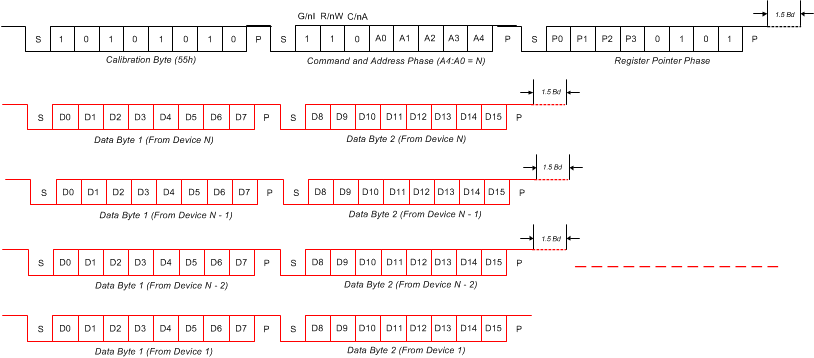SBOS716D May 2015 – January 2020 TMP107
PRODUCTION DATA.
- 1 Features
- 2 Applications
- 3 Description
- 4 Revision History
- 5 Pin Configuration and Functions
- 6 Specifications
-
7 Detailed Description
- 7.1 Overview
- 7.2 Functional Block Diagram
- 7.3 Feature Description
- 7.4 Device Functional Modes
- 7.5 Programming
- 7.6
Register Map
- 7.6.1 Temperature Register (address = 0h) [reset = 0h]
- 7.6.2 Configuration Register (address = 1h) [reset = A000h]
- 7.6.3 High Limit 1 Register (address = 2h) [reset = 7FFCh]
- 7.6.4 Low Limit 1 Register (address = 3h) [reset = 8000h]
- 7.6.5 High Limit 2 Register (address = 4h) [reset = 7FFCh]
- 7.6.6 Low Limit 2 Register (address = 5h) [reset = 8000h]
- 7.6.7 EEPROM n Register (where n = 1 to 8) (addresses = 6h to Dh) [reset = 0h]
- 7.6.8 Die ID Register (address = Fh) [reset = 1107h]
- 8 Application and Implementation
- 9 Power Supply Recommendations
- 10Layout
- 11Device and Documentation Support
- 12Mechanical, Packaging, and Orderable Information
Package Options
Mechanical Data (Package|Pins)
- D|8
Thermal pad, mechanical data (Package|Pins)
Orderable Information
7.3.3.2.2.4 Global Read
Use the global read address operation to read the value of the register pointed to by the Register Pointer Phase section. The daisy chain returns data starting from the address specified in the command or address phase, and ending with the address of the first device in the daisy chain. The data phase of the global read address operation is different from other address operations because the data phase consists of data read back from every device on the bus between the addressed device and first device, as shown in Figure 29. If the address specified exceeds the address of the last device, the operation halts and the bus times out after 35 ms. There is a delay of up to 1.5 baud before the devices respond back to the host. The host reads the data from the devices by synchronizing to the falling edge of the start bits.
 Figure 29. Global Read Operation
Figure 29. Global Read Operation